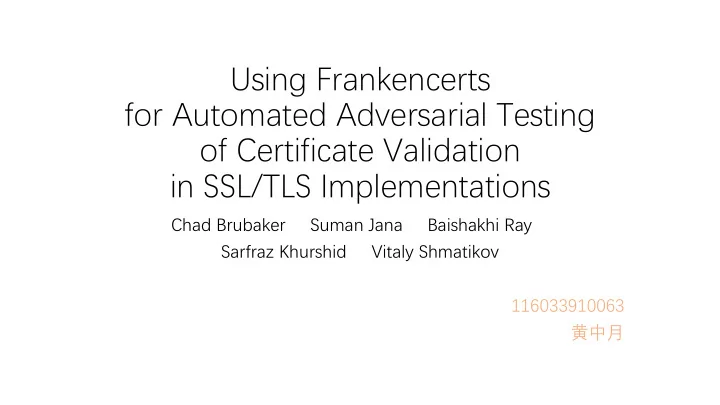

Using Frankencerts for Automated Adversarial Testing of Certificate Validation in SSL/TLS Implementations Chad Brubaker Suman Jana Baishakhi Ray Sarfraz Khurshid Vitaly Shmatikov 116033910063 黄中月
Content • SSL/TLS Protocol • Implementation Correctness • Certificate Generation • Differential Testing • Conclusion
SSL/TLS Protocol • End-to-end security even if the network is insecure • Authentication = certificate validation • Confidentiality • Integrity
SSL/TLS Protocol • Server authentication • X.509 certificate validation • Chain of trust • Basic constraints • Name constraints • Key usage • Hostname • Time • …
Implementation Correctness • Problem1: generating test inputs • Structurally complex data = Huge input space • Approach • Simple automated technique (Ex: random fuzzing) • A fuzzed string won't even parse as an X.509 cert • Manually creating certificates • Manually creating a high-quality suite is simply infeasible
Implementation Correctness • Problem2: interpreting test results test SSL/TLS accept/reject certificate implementation
Implementation Correctness • Problem1: generating test inputs • Frankencerts • Problem2: interpreting test results • Differential Testing
Certificate Generation • Requirements • Syntactically correct • Semantically bad • Scale to millions of certs • X.509 certificate structure • Multilayered structured data • Syntactic constraints • Ex: Version must be an integer • Semantic constraints • Ex: Version must be 0, 1, or 2
Certificate Generation • Step 1: collect 243,246 certificates
Certificate Generation • Step 2: generate 8,127,600 frankencerts
Certificate Generation • Step 3: mutate a few pieces
Differential Testing • 9 open-source SSL/TLS libraries • 6 Web browsers
Differential Testing • Results • 15 root causes • 208 discrepancies • 62,022 frankencerts • Error Reporting • Expired (E) • Bad issuer (I) • Bad name (N)
Differential Testing • Results
Differential Testing • Error Reporting
Differential Testing • Ex. Google Chrome
Conclusion • Differential testing with frankencerts is an effective technique for finding flaws in SSL/TLS implementations • The code is available at: https://github.com/sumanj/frankencert
Thanks Q&A
Recommend
More recommend